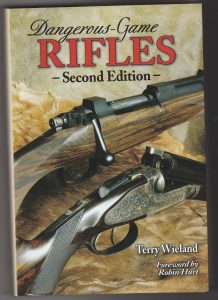
By Terry Wieland
Hard Cover 440 pages
Available from Rowman & Littlefield
1-800-462-6920
$40 +$5 Shipping
The second edition of this book is just coming off the press now but I have to point out a glaring mistake in it that can easily get the reader killed when dealing with dangerous African game.
I have seen more than one case of both a hunter and his guide killed by one of the “Big 5” that they couldn’t stop in time because both were using .375 H&H magnums instead of a proper dangerous game gun.
(The banning of the .375 for African dangerous game in multiple countries occurred years ago and I am not up on current African game regulations. When I was writing for Magnum in South Africa I was privy to a lot of information that did not get published lest it hurt the Safari business. Through my deep ties to the British gun trade and related ammunition developments for their big game cartridges I was privy to more skeletons in the closet. I was given a worldwide exclusive to announce the largest sporting rifle cartridge ever, the 2 bore, and also the last Rigby big game cartridge, the .775 Rigby. While I regard the .375 H&H Magnum as an excellent non dangerous game cartridge I am too aware of its failures to condone its use on dangerous game as that gets men killed. Advocating anything less than a .450 Nitro for dangerous game ultimately results in innocent blood on your hands and I am not willing to be responsible for those deaths.)
The .375 H&H Magnum is an excellent plains game gun for African game can be hard to kill but just because you can get away with using it on dangerous game sometimes is no reason to risk your life and the lives of the men around you by using an inadequate caliber. You can kill anything in Africa with a perfectly placed .30-06 steel jacked 220 grain solid but there is absolutely no margin for error whatsoever and you would be crazy to try it.
If you can’t handle the recoil of a .450 nitro or larger caliber then don’t hunt dangerous game. It isn’t that bad. I remember one workman at the bench in the British gun trade stating emphatically that anyone who can handle a 12-gauge shotgun can handle a .470.
The rest of the book is a good overview of the subject of dangerous game rifles although the super heavyweights, the .577 Nitro express and the .600 Nitro get insufficient attention and the old reliable 8 and 4 gauge stopping rifles from the Victorian era are conspicuously absent.
The book starts out with a general history then moves on to the famous British double rifles which are definitely the best in close encounters of the wild kind with adversaries that may be beyond your weight class by over 6 tons. The bolt actions are then properly covered along with single shots. The section on lever actions will be of interest to Canadian and Alaskan hunters but I would not choose one for dangerous African game.
The book moves onto cover the building of the various rifle types and a long section on cartridges and bullets. Finally there are chapters on using the dangerous game rifle along with a useful appendix with factory ballistic tables from the various manufacturers of the ammo.
Overall this is a good book on the subject as long as the reader recognizes the afore mentioned deficiencies.—Jim Dickson



